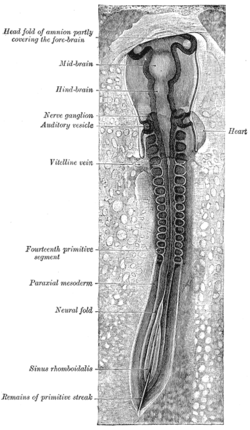Paraxial mesoderm
| Paraxial mesoderm | |
|---|---|

Transverse section of a chick embryo of forty-five hours’ incubation.
* Chordamesoderm: yellow, at . * Paraxial mesoderm: red, at somite. * Intermediate mesoderm: purple, near Wolffian duct. * Lateral plate mesoderm: purple, near "Somatic mesoderm" and "Splanchic mesoderm". |
|

Chick embryo of thirty-three hours’ incubation, viewed from the dorsal aspect. (Paraxial mesoderm labeled at left.)
|
|
| Details | |
| Carnegie stage | 9 |
| Gives rise to | somitomere, head mesoderm |
| Identifiers | |
| Latin | mesoderma paraxiale |
| Code | TE E5.0.2.1.0.0.3 |
|
Anatomical terminology
[]
|
|
Paraxial mesoderm, also known as presomitic or somitic mesoderm is the area of mesoderm in the neurulating embryo that flanks and forms simultaneously with the neural tube. The cells of this region give rise to somites, blocks of tissue running along both sides of the neural tube, which form muscle and the tissues of the back, including connective tissue and the dermis.
The paraxial and other regions of the mesoderm are thought to be specified by bone morphogenetic proteins, or BMPs, along an axis spanning from the center to the sides of the body. Members of the FGF family also play an important role, as does the WNT pathway. In particular, Noggin, a downstream target of the Wnt pathway, antagonizes BMP signaling, forming boundaries where antagonists meet and limiting this signaling to a particular region of the mesoderm. Together, these pathways provide the initial specification of the paraxial mesoderm and maintain this identity. This specification process has now been fully recapitulated in vitro with the formation of paraxial mesoderm progenitors from pluripotent stem cells, using a directed differentiation approach.
The tissue undergoes convergent extension as the primitive streak regresses, or as the embryo gastrulates. The extends from the base of the head to the tail; with it extend thick bands of paraxial mesoderm.
As the primitive streak continues to regress, somites form from the paraxial mesoderm by "budding off" rostrally.
In certain model systems, it has been shown that the daughter cells of stem cell-like progenitor cells which come from the primitive streak or site of gastrulation migrate out and localize in the posterior paraxial mesoderm. As the primitive streak regresses and somites bud off anteriorly, new cells derived from these stem-cell like precursors constantly enter the posterior end of the paraxial mesoderm.
...
Wikipedia
